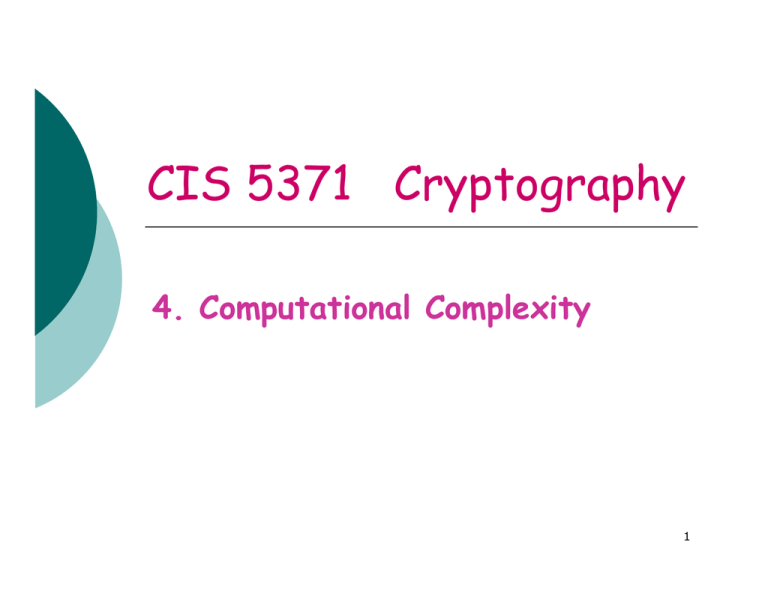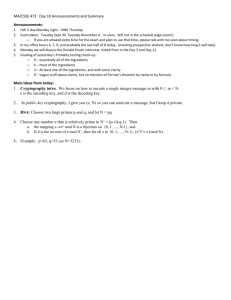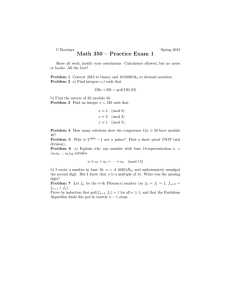CIS 5371 Cryptography 4. Computational Complexity 1
advertisement

CIS 5371 Cryptography 4. Computational Complexity 1 T i Machines Turing M hi s A finite state control unit k 1 tapes and read or write tapeheads FSC unit tapeheads 2 D t Deterministic i i ti P Polynomial l i l Ti Time Class P The class of languages L such that: any x L can be recognized by a TM in time bounded by a polynomial p(n), p(n) where n is the length of x. x A language recognition problem is a decisional problem. Class Pcan also be used to capture computational problems. Polynomial-time computational problems These must be computed p byy a TM in ppolynomial-time. y 3 Th Euclidean The E lid Algorithm Al ith Input: integers a > b 0 Output: gcd(a,b) i 0 ; r-1 a ; r0 b ; 2 while 2. hil ( ri 0 ) do d 1. a) .ri+1 . ri-1(mod ri) ; b) .ii i+1 3. return( ri-1 ) 4 A example An l a = 60, b = 9 ri-1 ri 60 9 9 6 6 3 3 0 3 = ggcd(60,9) ( , ) 5 The Extended E Euclidean E l Algorithm l I Input: t integers i a>b0 Output: integers , satisfying a+b = gcd(a,b) i 0 ; r-1 a ; r0 b ; q 0 -1 1 ; -1 0 ; 0 0 ; 0 1 2 while 2. hil ( ri = ai+bi 0 ) do d a) .q = ri-1 ri b)) .i+1 . i-1 i 1 - qi ; i+1 . i-1 i 1 - qi c) ri+1 . ri-1(mod ri) ; d) .i i+1 3. return(( (i , i) ) 1. 6 A example An l a = 60, b = 9 i r q -1 1 60 0 9 6 1 0 0 1 1 6 1 1 -6 2 3 3 0 2 -1 7 × × × 3 = 60(-1) + 9(7) 7 M d l arithmetic Modular ith ti Some exercises in modular addition multiplication and exponentiation. The computational complexity of modular addition and multiplication The computational complexity of modular exponentiation: the square & multiply algorithm l ih 8 M d l E Modular Exponentiation ti ti Input: integers x > 0, y > 0, n > 0. Output: x y (mod n) mod_exp(x,y,n). 1. 2. 3. if y = 0 return ( 1 ) ; if y = 0 (mod 2) return ( mod_exp(x2(mod n), y2, n ) ; return ( x mod_exp(x2(mod n), y2, n ). 9 P b bili ti P Probabilistic Polynomial l i l Ti Time A probabilistic Turing Machine (TM) is a nondeterministic TM with bounded error (<1/3). Class PP The class of languages L such that: any xL can be recognized by a probabilistic TM in time bounded by a polynomial p(n), where h n is i the th length l th off x. 10 PP (Monte Carlo) Al Always f fast, t probably b bl correctt L PP (Monte Carlo): if there exists a randomized algorithm g A such that for any instance I: Prob [ A recognizes I | I L ] = 1 and Prob [ A recognizes I | I L ] , where is a constant in the interval (0,1/2). 11 PP Monte Carlo Input : p, a positive number Output : Yes if p is prime, No otherwise. 1. Repeat log2 p times : a)) Pick a random number x in ((1,, p p-1)) ; b) If gcd(x,p) > 1 or if x (p-1)/2 1 (mod p) return ( No ) end of repeat ; 2. If ( test in 1.b never shows 1 ) return ( No ) 3. Return ( Yes ) 12 P i lit ttesting Primality ti Thi test This t t holds h ld because b Fermat’s little theorem: if p is a prime then: For any 0 < x <p : x p-1 1 (mod p) There are only two quadratic residues of 1: +1 and -1. If n is a composite number then there are at least 4 quadratic residues of 1 modulo n. Consequently we may have x (p-1)/2 1 (mod p) 13 PP ((Las Vegas) g ) Probably fast, always correct L PP (Las Vegas): if there exists a randomized algorithm A such that for any instance I: Prob [ A recognizes I | I L ] and Prob [ A recognizes I | I L ] = 0, 0 where is a constant in the interval (1/2,1). 14 PP Las Ve Vegas as Input : p p, an odd positive number q1,q2,…, qk: all prime factors of p-1 Output p : Yes if f p is p prime,, No otherwise. No decision with certain probability of error 11. 2. 33. 4. Pick g U [2,p [2 p-1] 1] For ( i=1, i++, k ) do if g (p-1)/qi = 1 (mod p) output NO_DECISION and terminate; if g p-11 1 (mod ( d p)) output NO andd terminate; i Output YES and terminate. 15 P i lit ttesting Primality ti This test holds because p is a prime iff there exists some g [2,p [2 p-1] 1] g p-1 1 (mod p), ( 1)/ i 1 (mod g (p-1)/q ( d p)) for f all ll factors f off p-1. 1 16 N d t Non-deterministic i i ti P Polynomial l i l Ti Time Class NP These are recognized by non-deterministic Turing Machine in polynomial time. Instances of NP problems have witnesses which can be found by random guessing: given a witness, every language (decisional problem) is recognizable in polynomial time. 17 Class NP -- examples Square-freeness Quadratic residuocity Other examples. Clearly we have: P NP problems 18 Cl ss NP-Complete Class NP C m l t A general discussion on NP-completeness. 19







